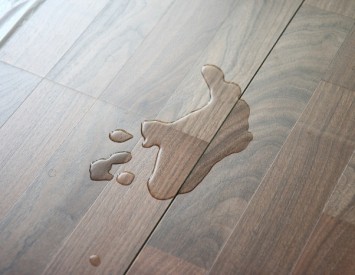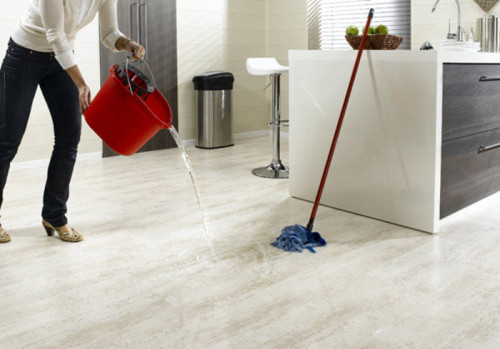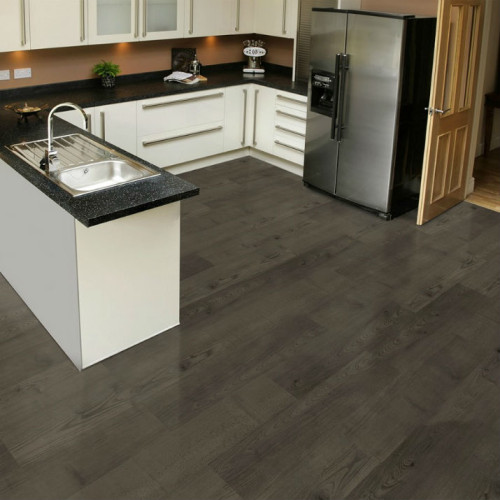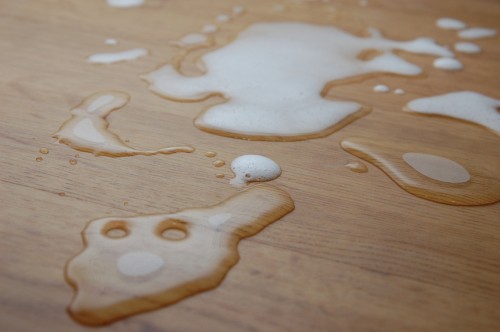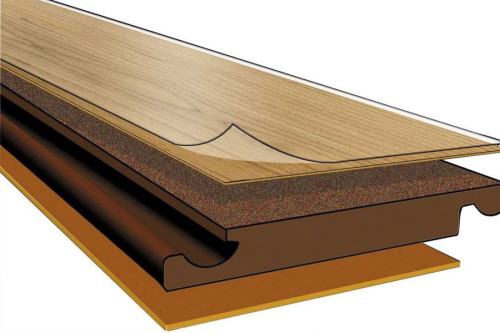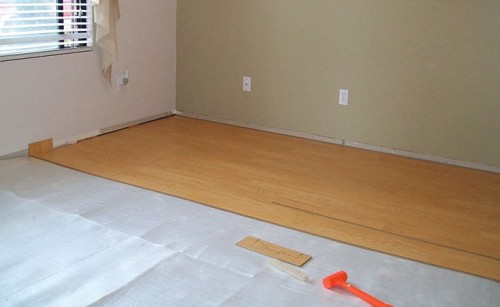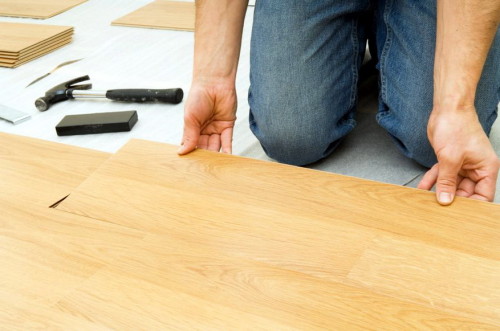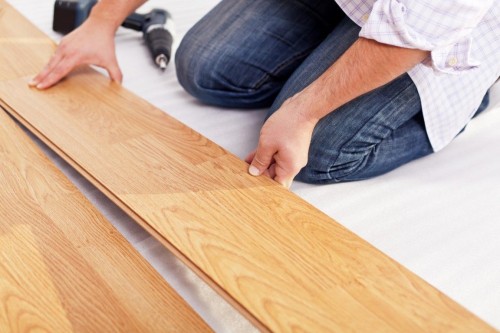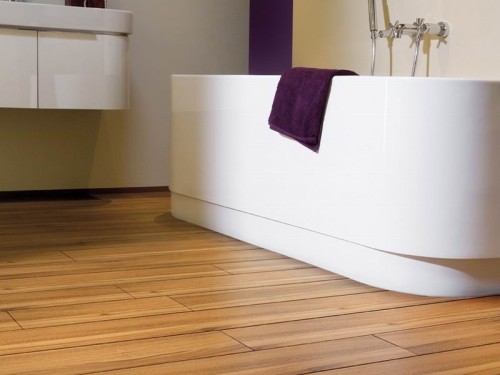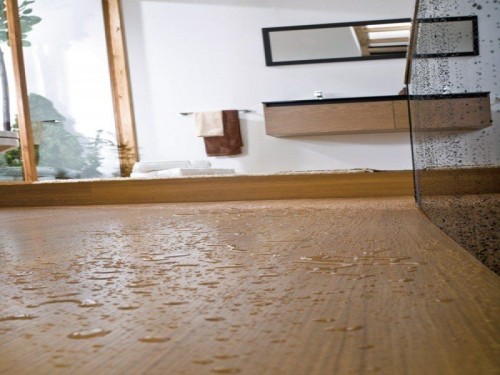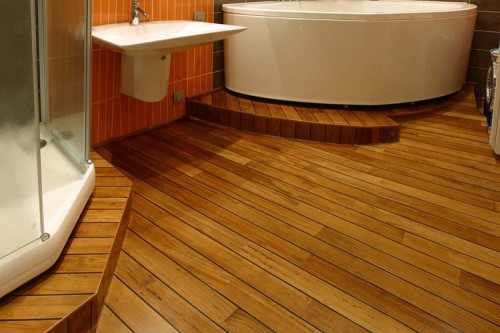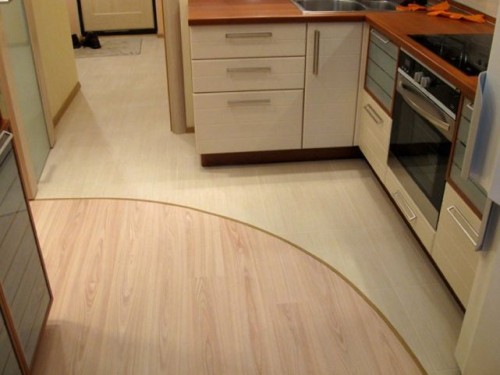The floor, covered with laminate, always looks beautiful, spectacular, stylish and comfortable. Many are used to using a similar type of coating in living rooms: bedrooms, halls, halls and living rooms. But fortunately, such a material can even decorate rooms with high humidity, for example, a kitchen or bathroom. In this case, you will have to use a waterproof laminate.
Content
Why is it worth using a laminate in the kitchen
Even an ordinary laminate is less susceptible to the destructive action of moisture than a parquet or a massive board. The reason for this is the smaller content of wood in the composition of the material. As for the waterproof laminate, the process of its production is built in such a way that the finished products have good water -repellent properties, which is why this material is great for use in kitchens and in bathrooms.
Of course, the floor in the kitchen is not necessary to cover with a laminate, you can use linoleum or tile. But, nevertheless, a waterproof laminate for the kitchen has a number of advantages over its analogues:
- The decorativeness of the material is considered one of its main advantages. The laminate always looks stylish, beautiful and attractive. Such a coating simulates real wood, and often distinguishing imitation from the original is quite difficult. Such a floor fits perfectly into almost any interior, regardless of its stylistic design. In addition, the laminate imitating noble wood of wood looks luxurious and expensive.
- The price of a waterproof laminate is lower than the cost of ceramic tiles.
- It will not be difficult to cover the floor with such material, even if you are a beginner in this matter and have never before encountered such work.
- If, for any reason, there is a need to replace part of the coating or remove it entirely, then it will not be difficult to dismantle the laminate in a short time. But removing ceramic tiles from the floor will be much more difficult and longer.
- The waterproof laminate of grades 32 and 33 is very durable, its service life reaches 25 years.
Types and characteristics of the material
The modern laminate is made from HDF stamps, which contain resins that glue all the components among themselves. The resin, as a water-repellent substance, does not allow water and dampness to penetrate the material, however, the structure of wood assumes the presence of the so-called bridges, through which a certain percentage of moisture nevertheless enters the stoves. These bridges of wood fibers can often be seen on the ends of individual elements where locks are located. It is worth noting that the more complicated and intricate the structure of the castle, the more water can get into the laminate.
In total, 3 main types of laminate are distinguished:
- Material made of standard HDF panels with a density of 900 kg/m 3. This type of coating can withstand the 3-hour effect of water, while not deforming.
- The laminate made from HDF panels with a high content of resins is more reliable, since it is able to withstand the 6-hour water exposure. After drying such a material, bloating and other damage is not formed on it. As a rule, on such products, manufacturers put the “Aqua” mark, which indicates that the laminate is moisture -resistant.
- The most resistant to moisture is a plastic laminate made of polyvinyl chloride. Due to the fact that there is no wood among the components of the material at all, such a laminate is absolutely not susceptible to the negative effects of humidity and water.
A waterproof laminate made of wood materials is protected from dampness in the following ways:
- apply to the surface of the plates of the resin layer;
- impregnate products with resin compounds;
- provide the laminate of a reliable lower layer, which also contains an increased amount of resins;
- the ends and locks of products are impregnated with substances based on wax or paraffin.
Differences of waterproof and moisture -resistant laminates
Many believe that waterproof and moisture -resistant are called the same type of material, but these concepts have some differences. Let us consider in more detail what is a moisture -resistant laminate:
- This type of material is made from HDF stages. Looking at the end of the laminate, the stove can be seen with the naked eye on a characteristic green hue.
- The locks on the moisture -resistant laminate are covered with a layer of wax or paraffin, which allows you to protect the most vulnerable places of wood from water and moisture.
- The material during production is treated with special antibacterial compounds so that fungi and mold do not develop on the floor.
- The moisture -resistant laminate is designed for the effects of high humidity, but it is not able to withstand the direct ingress of water for a long time. This type of material is suitable for use in the kitchen, but it is undesirable to use it as a floor covering of the bathroom.
Waterproof material is distinguished by the following features:
- It is made from plates that are made by pressing wood under high pressure.
- Like the previous type of material, the structure of waterproof laminate includes several layers, but in this case all the ends and joints are additionally sealed using molten wax.
- A layer of a special polymer is applied to the surface of waterproof material, which not only protects the slabs from water, but also prevents the formation of scratches. With such a coating, you can be sure that moisture will not get inside due to any physical damage to the laminate.
Important: by purchasing a waterproof laminate, carefully inspect the locks on the ends of the products. High -quality wax impregnation makes them shine and look like they are wet. If you scratch the shiny surface with a fingernail, nothing will happen to it, and it will remain in the same form. If the wax remains under the nails, then the material has low quality and it should not be bought.
Features of choosing a waterproof laminate
Fortunately, the modern market for building materials offers customers a widest range of various products. The same applies to the laminate. Due to the variety of textures, colors, shades, drawings and images, everyone will be able to choose products to their liking by realizing design ideas and entering such a coating in any interior style.
When choosing a waterproof laminate, attention should be paid to some features:
- Before buying a waterproof laminate, you need to study information about manufacturers who represent their goods on the market. It is advisable to give preference to those brands that have established themselves among consumers. The waterproof laminate of the production of Germany is considered a high -quality and reliable: “Egger”, “Kronotex”, “Tarkett” and others.
- When choosing the material, pay attention to its upper coating - it should have good wear resistance, then the laminate will last you for many years.
- The laminate does not always resemble wooden boards in its appearance, sometimes its texture imitates tiles. If you decide to give preference to this particular type of material, then some of its features should be noted. Firstly, the laminate with imitation for the tile has non-standard sizes and shape. It is represented in the form of tiles with sides 40x40 cm and 120x40 cm. A similar laminate also has a glossy surface.
- There are 6 classes of waterproof laminate, which is used to cover the floor in residential premises. You need to purchase the material for reasons of which rooms you are going to use it. The laminate class is indicated on the packaging with the goods.
- The factory packaging should also have information about the maximum permissible loads that can withstand a particular coating.
- The service life of the material is also of great importance.
Important: Before buying the goods, specify whether the seller has quality certificates for the products that he sells. Most often, in specialized stores or pavilions with building materials, sellers are ready to provide all the necessary documents.
A waterproof laminate of 12 mm thick is suitable for use in the kitchen. Such a coating can withstand strong physical activity and can last several decades. The laminate of classes 32 and 33 has very high quality, so many manufacturers provide a lifelong warranty for such products. The only condition is that such a laminate is necessary only in residential premises.
When purchasing a waterproof laminate, you need to consider some points:
- Even the highest quality coating can deteriorate from time or various influences on which it is not designed. Therefore, you need to buy products with a small margin, which will be approximately 15% of the total amount of material. In case of damage to individual fragments, they can be replaced.
- When installing a laminate, you should not use a cork as a substrate, it is better to give preference to PVC materials. The cork, like a tree, absorbs moisture well, subsequently evaporating it into the external environment.
- The thickness of the substrate when laying the laminate should be approximately 3 mm.
- All joints between individual elements should be carefully sealed. As a sealant, you can use silicone compounds, which close the cracks when installing windows, because such materials have an acceptable cost and good quality.
DIY laminate laying
Preparatory work
All construction and repair work begins with the preparatory stage. When laying the laminate, the preparation provides for a thorough inspection of the floor, in the process of such an inspection, the quality and strength of the coating should be determined, as well as the presence of level changes. The wooden floor must be sanded with a special machine that will help smooth out all the bumps. If there are too large slots between individual boards, it is advisable to eliminate them. It happens that the plank floor is in a very unsatisfactory condition, in this case it is best to lay plywood sheets on it.
The preparation of the concrete floor is carried out faster and easier. To align the plane and eliminate all the disadvantages, you just need to make a screed from cement, latex or silicone solution.
Laying a substrate for waterproof laminate
The substrate is the necessary layer between the floor and the laminate. Its value is determined by several functions:
- Using the substrate, you can hide the small disadvantages of the base coating: minor levels of level, small recesses, cracks, protrusions.
- The substrate performs the shock -absorbing function, making walking on the laminate soft and comfortable.
- This layer is also noise -absorbing.
- The substrate of synthetic materials is waterproof and has vapor barrier properties.
In the construction market you can find several types of substrate: synthetic, cork, as well as a substrate from a cork with rubber filling. As mentioned earlier, when laying a waterproof laminate, it is recommended to use synthetic materials, since in rooms with a constantly high humidity level there is a risk of penetration of dampness under the laminate. The traffic jam, unlike polyvinyl chloride, is inclined to absorb water, which does not affect the durability of the coating in the best way.
The substrate is usually sold in rolls. The process of laying it does not represent anything complicated, the roll must be rolled to a suitable length and cut off the necessary fragment. It is better to lay the substrate, the neighboring sheets of the material should overlap each other by 5-10 cm.
Laying waterproof laminate
The laminate laying process also does not require any special skills or skills. First you need to decide in which direction individual elements will be placed: along the room, across the room or diagonally. Those who are engaged in such work for the first time, it is better to dwell on the first option and lay a laminate along the room. Such styling is easier and faster, and the joints between individual fragments are not so noticeable in daylight.
We describe the process of laying the laminate step by step:
- To begin with, along the perimeter of the room you need to install spacer wedges, they are located on the walls, focusing on the level of laying of the laminate. The wedges are small in size wooden or plastic products, with the help of which a gap of 8-10 mm is created between the wall and the laminate. Since with a temperature difference in the room the floor covering will expand or narrow, such a gap will provide the material with additional space.
- Laminate laying is better to start from the corner of the room. To begin with, 2 panels of the first row are mounted on the floor, after which the second row is laid. In the process of work, fragments of the laminate are installed in such a way that they resemble brick masonry by appearance. This is necessary so that future loads are evenly distributed throughout the area of \u200b\u200bthe room.
- The first fragment of the second row is half the whole panel. After installing it, the second panel is laid nearby, which no longer needs to be cut into 2 parts.
- Similarly, the entire floor is covered with a waterproof laminate. All elements are fastened with each other with locks. There are 2 types of similar systems: Lock and Click. In the Lock system, the panels are connected in a horizontal plane. In the second case, the elements are inserted into each other at an angle of 30-45 °, and after lowering the part, you can hear a characteristic click.
- When laying the latest elements, difficulties may arise, so when installing a laminate near the wall, it will be convenient to use a clamp. One end of the clamp is installed on the edge of the laminate, and according to the second, it should be slightly hit with a hammer.
Waterproof laminate, photo:
